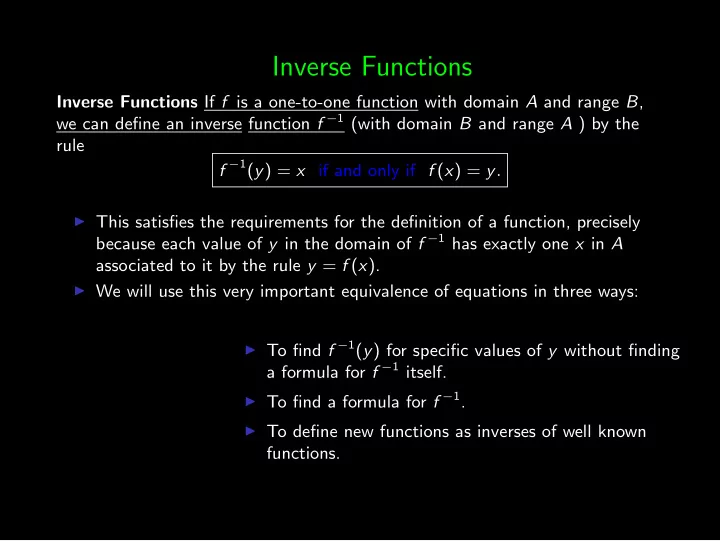

Inverse Functions Inverse Functions If f is a one-to-one function with domain A and range B , we can define an inverse function f − 1 (with domain B and range A ) by the rule f − 1 ( y ) = x if and only if f ( x ) = y . ◮ This satisfies the requirements for the definition of a function, precisely because each value of y in the domain of f − 1 has exactly one x in A associated to it by the rule y = f ( x ). ◮ We will use this very important equivalence of equations in three ways: ◮ To find f − 1 ( y ) for specific values of y without finding a formula for f − 1 itself. ◮ To find a formula for f − 1 . ◮ To define new functions as inverses of well known functions.
Finding f − 1 ( y ) for specific values of y . If f ( x ) = x 3 + 1, use the equivalence of equations given Example: above find f − 1 (9). ◮ We first write out our equivalence of equations: f − 1 ( y ) = x if and only if f ( x ) = y . ◮ Replacing y by 9 tells us that f − 1 (9) = x is the same as saying that f ( x ) = 9 . ◮ Substituting the formula for f tells us that x 3 + 1 = 9 . f − 1 (9) = x is the same as saying that ◮ Thus solving for x in x 3 = 8 . which gives f − 1 (9) = x is the same as solving for x in x = 2. ◮ Thus f − 1 (9) = 2. ◮ Try to repeat this process to find f − 1 (28) before you see the solution. (Do not solve this by finding a formula for the inverse function, the purpose of this exercise to is learn the above method.)
Finding f − 1 ( y ) for specific values of y . If f ( x ) = x 3 + 1, find f − 1 (28). Example: ◮ f − 1 ( y ) = x if and only if f ( x ) = y . ◮ This tells us that f − 1 (28) = x if and only if f ( x ) = 28 . ◮ Therefore f − 1 (28) = x if and only if x 3 + 1 = 28 . ◮ Thus f − 1 (28) = x if and only if x 3 = 27 . which is the same as saying that x = 3. ◮ Thus f − 1 (28) = 3. ◮ Note: the statement of equivalence “if and only if” is often abbreviated to iff or ⇐ ⇒ in mathematics.
A bit of guesswork Example: If g ( x ) = cos( x ) + 2 x , find g − 1 (1). ◮ In this case, we know that g is a one-to-one function (why?) ◮ Because g ′ ( x ) = 2 − sin ( x ) > 0. ◮ We know g − 1 (1) = x ⇐ ⇒ 1 = cos( x ) + 2 x (using g − 1 (1) = x is the same as g ( x ) = 1). ◮ It is difficult to solve for x in the equation 1 = cos( x ) + 2 x but in this case we can guess: ◮ We know that cos(0) = 1, therefore cos(0) + 2(0) = 1 and x = 0 must the unique value of x which fits the equation 1 = cos( x ) + 2 x . ◮ Thus g − 1 (1) = 0.
Domains and Ranges Note that the domain of f − 1 equals the range of f and the range of f − 1 equals the domain of f . ◮ Example Let g ( x ) = √ 4 x + 4. ◮ What is Domain g ? The domain of g is all values of x for which 4 x + 4 ≥ 0 i.e. { x | x ≥ − 1 } . ◮ What is Range g ? The range of g is { y | y ≥ 0 } . ◮ Does g − 1 exist? ◮ Yes because g is a 1-1 function. ◮ What is the domain and range of g − 1 ? ◮ The domain of g − 1 is the range of g which is { x | x ≥ 0 } . ◮ The range of g − 1 is the domain of g which is { x | x ≥ − 1 } . ◮ What is g − 1 (4)? ◮ g − 1 (4) = x ⇐ ⇒ g ( x ) = 4 ⇐ ⇒ √ 4 x + 4 = 4 ⇐ ⇒ 4 x + 4 = 16 ⇐ ⇒ 4 x = 12 ⇐ ⇒ x = 3. i.e. g − 1 (4) = 3.
Recommend
More recommend